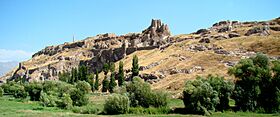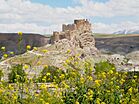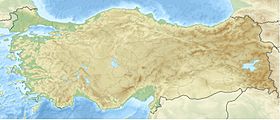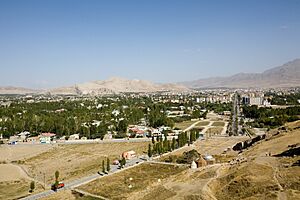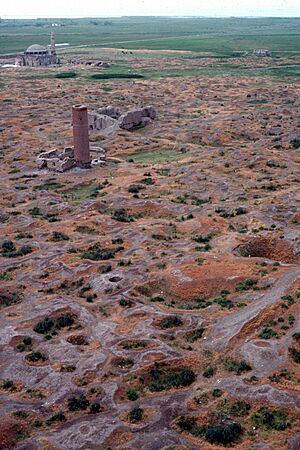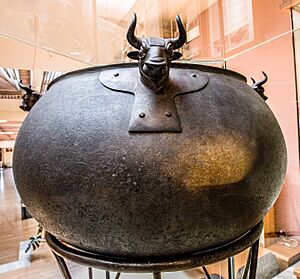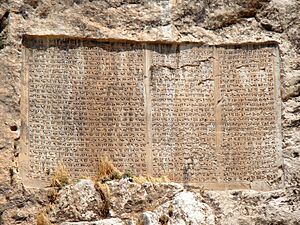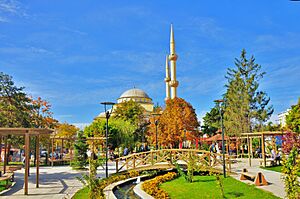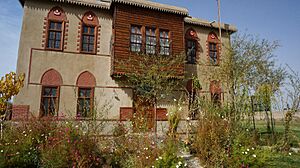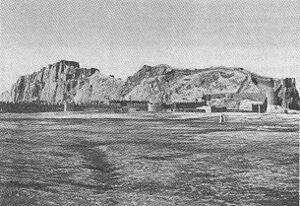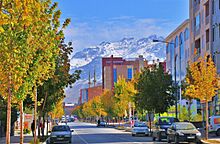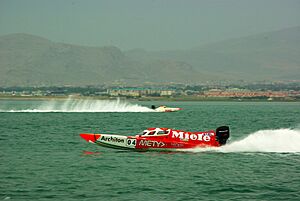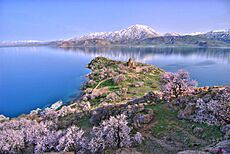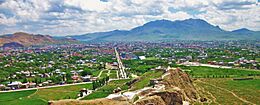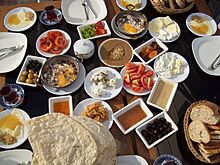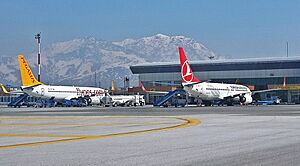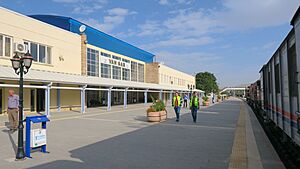Van, Turkey facts for kids
Quick facts for kids
Van
|
||
|---|---|---|
|
City
|
||
|
Clockwise from top: Van Fortress; Cathedral of the Holy Cross, Aghtamar; Tushba; Muradiye Waterfalls; İskele Street; Van Lake; and Hoşap Castle
|
||
|
||
| Country | Turkey | |
| Region | Eastern Anatolia | |
| Province | Van | |
| Elevation | 1,726 m (5,663 ft) | |
| Population
(end 2022)
|
||
| • City | 525,016 | |
Van (Armenian: Վան; Kurdish: Wan) is a city in eastern Turkey. It sits on the eastern shore of Lake Van. This city is the capital and largest city of Van Province.
Van has a very long and interesting history. It has been an important city for thousands of years. It was once called Tushpa. This was the capital of the ancient Urartu kingdom from the 9th to the 6th century BCE. Later, it became a key center for the Armenian kingdom of Vaspurakan. Turkic people arrived in Van and other parts of Anatolia after the Seljuk victory at the Battle of Malazgirt in 1071.
Van was home to many Armenians until the 1910s. Today, most people living there are Kurds.
Contents
History of Van
Digs and studies in Van Province show that people have lived here for a very long time. Human settlements date back to at least 5000 BCE. The Tilkitepe Mound, near Lake Van, tells us about the oldest cultures in this area.
Ancient Kingdoms and Empires
Van was first known as Tushpa. It was the capital of the Urartian kingdom in the 9th century BCE. The first settlement was built around a steep hill called Van Castle. This castle is near Lake Van, a few kilometers west of the modern city. Ancient writings from the 8th and 7th centuries BCE have been found here. The name 'Van' comes from the Urartian word Biaina.
Later, the region was ruled by the Orontids. Then, in the mid-6th century BCE, the Persians took control. Van Fortress has a famous inscription from Xerxes the Great from the 5th century BCE. This writing is high up on the rock face. It is in three different languages: Old Persian, Babylonian, and Elamite.
In 331 BCE, Alexander the Great conquered Van. After he died, it became part of the Seleucid Empire. By the 2nd century BCE, it was part of the Kingdom of Armenia. It became an important city under the Armenian king, Tigranes II. He founded the city of Tigranakert in the 1st century BCE.
Byzantine, Sassanian, and Artsruni Rule
After the Parthian Empire fell, the new Sassanian Empire took over Van. For over 700 years, the Roman-Persian Wars were fought in and around Van. The Byzantine Empire briefly held the region from 628 to 640. Then, Muslim Arabs invaded and made it part of their province called Arminiya.
As Arab power weakened, local Armenian rulers became strong again. The Artsruni family became the most powerful. They declared their independence in 908. This led to the Armenian Kingdom of Vaspurakan. This kingdom did not have one fixed capital. The king would move his court to different places like Van city, Vostan, or Aghtamar. In 1021, the last king, John-Senekerim Artsruni, gave his kingdom to the Byzantine Empire. The Byzantines called Van Eua or Eva (Ancient Greek: Εύα).
Seljuk and Mongol Influence
The Seljuk Turks began moving into Vaspurakan in the 1050s. After their victory at the battle of Manzikert in 1071, they controlled the whole region. After them, local Muslim rulers like the Ahlatshahs and Kurdish Ayyubids (from 1207) took over. Van was held by the Anatolian Seljuk Sultanate for 20 years. Then, in the 1240s, the Mongols conquered it. In the 14th century, the Timurids ruled Van. After them came the Turkoman groups Kara Koyunlu and Ak Koyunlu.
Ottoman Era and Changes
In the early 15th century, Van became a place of conflict. Both the Ottoman Empire and the Persian Safavid Empire wanted control. The Safavids captured Van in 1502. The Ottomans took it in 1515 but lost it again in 1520. The Ottomans finally gained strong control in 1548. This was confirmed by the Peace of Amasya in 1555.
The Ottomans first made Van a smaller administrative area. Later, around 1570, it became a separate province called Van eyalet. In 1604, the Safavids under King Abbas the Great recaptured Van. However, Ottoman control was made final in 1639 with the Treaty of Zuhab.
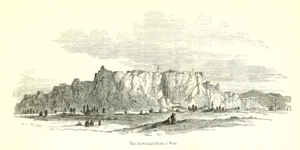
In the early 1900s, Van had many schools, both Armenian and Turkish. In the late 1800s, Van became more important in Ottoman politics. This was because of its location near the borders of the Persian, Russian, and Ottoman Empires.
Population Changes
Before World War I, Van city had about 50,000 people. Around 30,000 were Armenian and 20,000 were Muslim. The population of Van province changed over time. In 1914, official records showed many Muslims and Armenians. Other groups like Assyrians were also present. The borders of the province also changed, which affected population numbers.
Turkish War of Independence
After World War I, the Entente Powers wanted to give Van to the First Republic of Armenia. However, Turkish revolutionaries, led by Mustafa Kemal Atatürk, did not agree. They fought the Turkish War of Independence. By 1920, Van was under Turkish control again. The remaining Armenian residents left the city. With the Treaty of Lausanne and Treaty of Kars, Van officially became part of Turkey.
By the end of these conflicts, Van was empty and in ruins. The city was rebuilt a few kilometers east of the old castle. The new city is about 1,750 metres (5,741 feet) above sea level.
Things to See in Van
Van has many interesting places to visit. Some of the main attractions are:
- Hoşap Castle
- Muradiye Fall (a waterfall)
- Akdamar Island
- Van Castle
- Lake Turna
- Lake Akgöl
- Van Museum
Population of Van
At the end of 2022, the city of Van had 525,016 people. Some estimates say it might be as high as 600,000. The old central district of Van was very large. It has since been divided into two new districts: İpekyolu and Tuşba. Today, most people in Van are Kurdish, with a smaller Turkish population.
Geography and Climate
The city of Van is located at the western base of Mount Erek.
Van's Weather
Van has a climate with cold, snowy winters and very warm, dry summers. It often rains or snows for most of the year. Spring and autumn usually have the most rain. July to September are usually dry.
| Climate data for Van (1991–2020, extremes 1939–2023) | |||||||||||||
|---|---|---|---|---|---|---|---|---|---|---|---|---|---|
| Month | Jan | Feb | Mar | Apr | May | Jun | Jul | Aug | Sep | Oct | Nov | Dec | Year |
| Record high °C (°F) | 12.6 (54.7) |
14.3 (57.7) |
22.7 (72.9) |
27.2 (81.0) |
29.3 (84.7) |
33.5 (92.3) |
37.5 (99.5) |
36.7 (98.1) |
35.0 (95.0) |
28.8 (83.8) |
20.1 (68.2) |
15.5 (59.9) |
37.5 (99.5) |
| Mean daily maximum °C (°F) | 2.9 (37.2) |
3.5 (38.3) |
7.5 (45.5) |
13.2 (55.8) |
18.6 (65.5) |
24.3 (75.7) |
28.3 (82.9) |
28.8 (83.8) |
24.4 (75.9) |
17.8 (64.0) |
10.3 (50.5) |
5.2 (41.4) |
15.4 (59.7) |
| Daily mean °C (°F) | −2.1 (28.2) |
−1.2 (29.8) |
2.9 (37.2) |
8.4 (47.1) |
13.4 (56.1) |
18.8 (65.8) |
22.7 (72.9) |
22.9 (73.2) |
18.4 (65.1) |
12.1 (53.8) |
5.2 (41.4) |
0.2 (32.4) |
10.1 (50.2) |
| Mean daily minimum °C (°F) | −6 (21) |
−5.2 (22.6) |
−1.2 (29.8) |
3.6 (38.5) |
8.0 (46.4) |
12.3 (54.1) |
16.0 (60.8) |
16.2 (61.2) |
12.0 (53.6) |
6.8 (44.2) |
0.9 (33.6) |
−3.6 (25.5) |
5.0 (41.0) |
| Record low °C (°F) | −28.7 (−19.7) |
−28.2 (−18.8) |
−22.7 (−8.9) |
−13.1 (8.4) |
−3.5 (25.7) |
−2.6 (27.3) |
3.6 (38.5) |
5.0 (41.0) |
−0.1 (31.8) |
−14 (7) |
−18.6 (−1.5) |
−21.3 (−6.3) |
−28.7 (−19.7) |
| Average precipitation mm (inches) | 32.9 (1.30) |
35.4 (1.39) |
49.0 (1.93) |
57.2 (2.25) |
45.8 (1.80) |
16.6 (0.65) |
7.9 (0.31) |
5.6 (0.22) |
19.9 (0.78) |
45.9 (1.81) |
48.8 (1.92) |
45.2 (1.78) |
410.2 (16.15) |
| Average precipitation days | 9.83 | 10.7 | 12.57 | 12.43 | 12 | 5.23 | 2.37 | 1.3 | 2.6 | 8.07 | 8.7 | 10.53 | 95.8 |
| Average snowy days | 11.67 | 10.88 | 9.13 | 1.58 | 0.08 | 0 | 0 | 0 | 0 | 0.17 | 2.75 | 10 | 46.26 |
| Average relative humidity (%) | 67.4 | 68.2 | 66.1 | 60.2 | 55.9 | 47.6 | 42.9 | 40.9 | 44.3 | 57.4 | 64.5 | 68.0 | 56.9 |
| Mean monthly sunshine hours | 155.0 | 161.0 | 201.5 | 231.0 | 294.5 | 351.0 | 372.0 | 347.2 | 306.0 | 232.5 | 177.0 | 127.1 | 2,955.8 |
| Mean daily sunshine hours | 5.0 | 5.7 | 6.5 | 7.7 | 9.5 | 11.7 | 12.0 | 11.2 | 10.2 | 7.5 | 5.9 | 4.1 | 8.1 |
| Source 1: Turkish State Meteorological Service | |||||||||||||
| Source 2: NOAA (humidity, 1991–2020), Meteomanz | |||||||||||||
City Features
The modern city is on a flat plain, about 5 kilometres (3 miles) from Lake Van. Some people have reported seeing a mysterious Lake Van Monster in the lake! Lake Erçek is another large lake nearby, just east of Lake Van.
Van is often called "The Pearl of the East" because of its beautiful scenery. An old saying about Van is "Van in this world, paradise in the next." In Turkish, it's "Dünyada Van, ahirette iman" which means "Van for this world, faith for the next."
The city is home to Van Yüzüncü Yıl Üniversitesi (Van 100th Year University).
Earthquakes in Van
Van has experienced earthquakes. In 1941, a strong earthquake hit the city. A more powerful earthquake happened on October 23, 2011. Another earthquake on November 9, 2011, caused buildings to fall.
Van's Food Culture
Van is famous for its special breakfast culture. While some Turkish cities are known for their kebabs, Van stands out with its unique breakfast dishes.
Getting Around Van
Van is located on Highway D300. This road goes from the Iranian border (about 100 km east) through Van. It then follows the south shore of Lake Van to Tatvan (100 km away). The highway also goes west to other parts of Turkey. Highway D975 runs north to Dogubeyazit and south towards Hakkari. You can find many buses and shared taxis (dolmuses) on these highways.
Van is the end point of the railway line from Iran. It has trains for both goods and passengers. There is also a train ferry that crosses Lake Van to Tatvan. There is no railway around the lake yet, but there are plans to build one in the future. This would connect Europe and the Indian subcontinent by rail, as Tatvan is linked to Ankara and Istanbul.
Van also has daily flights to major Turkish cities like Istanbul and Ankara from Ferit Melen Airport.
Media in Van
Near Van, there is a large radio broadcasting station. It has a 250-metre-tall (820-foot) tower. It started in 1990 and broadcasts on 225 kHz. Van also has local news sources like Van Gazetesi and Gazete Van.
Famous People from Van
- Hanımzer Melet (born 1993), a national team wheelchair basketball player.
The Van Cat
The Van cat is a special type of cat that comes from this city. It is named after Van. These cats are known for their white fur and often have different colored eyes.
Van's Sister Cities
Van is connected with other cities around the world. These are called twin towns or sister cities:
Images for kids
See also
 In Spanish: Van (ciudad) para niños
In Spanish: Van (ciudad) para niños


